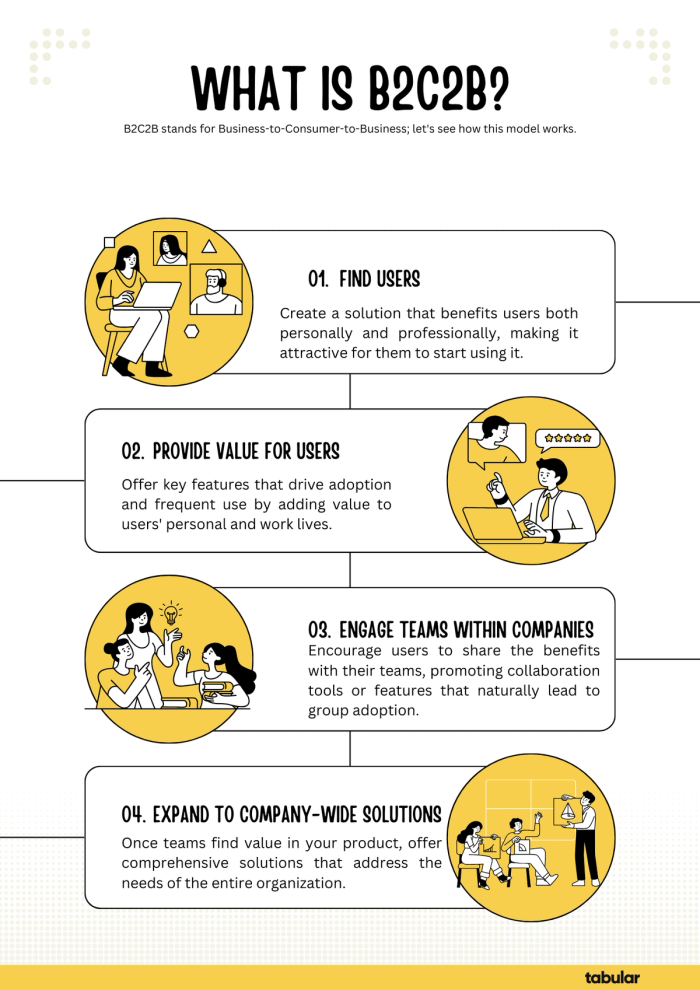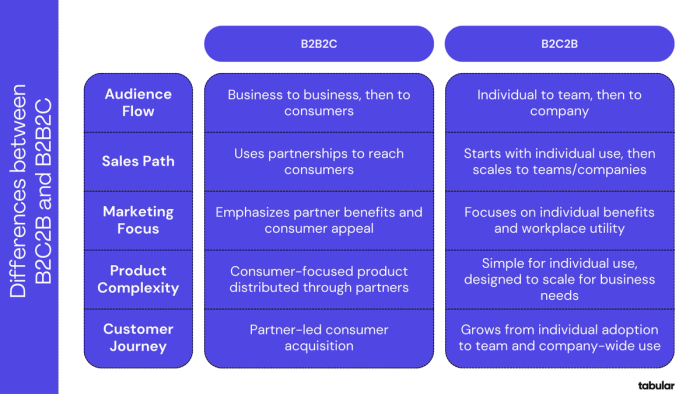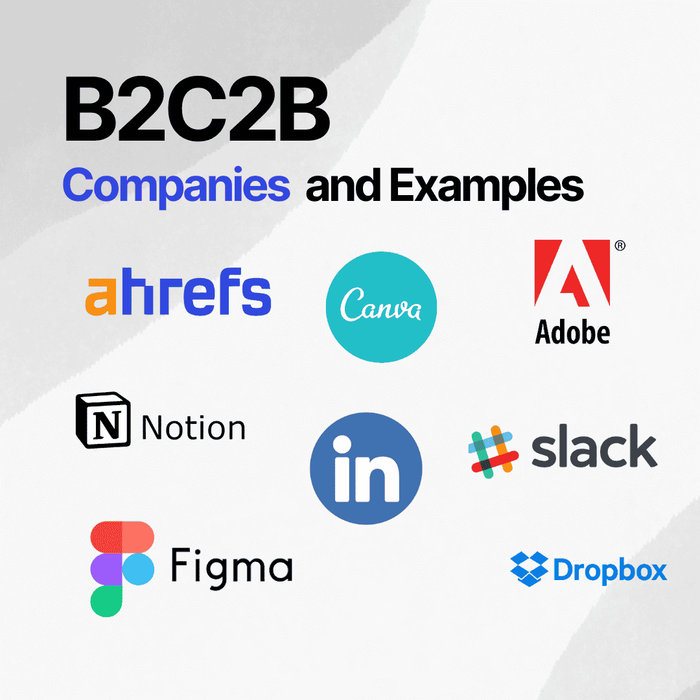B2C2B Business Model with Examples
If you've been in marketing for a while, you're probably familiar with business models like B2B and B2C. B2B involves businesses interacting directly with other businesses, while B2C focuses on direct engagement between a business and its customers. While these models are well-known, what is B2C2B?
As the name suggests, B2C2B stands for Business-to-Customer-to-Business. It is a hybrid model that considers a business’s employees as customers. In this article, we’ll provide an in-depth explanation of the B2C2B business model, exploring current trends, ways to transition to a B2C2B approach, and its potential for the future.
What is B2C2B?
B2C2B is a business model where a company sells to individual consumers, who then bring in their workplace or business to buy the product too.
For example, LinkedIn sells premium subscriptions to individual users for networking and career development; once they see the benefits, they encourage their company to adopt LinkedIn for recruitment or sales.

In the B2C2B model, you need to engage with the employees of a company before reaching the business itself. If your goal is to have your product or service widely used across a business, you must first cater to the needs of its employees. By addressing their specific challenges, work motivations, and gaps in their daily routines, you can pinpoint relevant pain points. Once you connect with them and promote your offering, your product can gain traction through word of mouth, creating a snowball effect. As this leads to broader corporate adoption, you can then transition to making sales on a business-to-business level.
Create your template using our email template builder.
The B2C2B Business Model
- First, target individuals to use your service; the solution you offer should benefit them both personally and in an office environment. LinkedIn gets people to sign up by providing a platform to build networks and offering business solutions to companies.
- Offer features and tools that add value to users’ professional growth. LinkedIn provides a freemium model with options to upgrade to LinkedIn Premium, offering networking, learning, and job opportunities.
- As individuals find value, encourage team adoption by providing tools that enhance collaboration and workflow. LinkedIn’s Recruiter and Sales Navigator offer benefits for HR, sales, and team communication.
- Once multiple teams within a company use your service, offer comprehensive solutions for the entire business. LinkedIn does this by providing Talent Solutions, enterprise Learning, and marketing tools that appeal to the whole organization.
Create your template using our email template builder.
How B2C2B Transforms Sales
We've discussed how the B2C2B business model can boost sales by targeting both individual consumers and businesses, leading to substantial revenue growth. However, it's one thing to explain the concept and another to actually convert this engagement into sales. Here's how to make that happen:
- Direct Engagement: In B2C2B marketing, the primary focus is on attracting individual users. This means you need to prioritize direct engagement with employees. A well-designed email template can encourage them to become advocates for your product within their company.
- Corporate Adoption: By offering a personalized experience, you can turn individual engagement into widespread corporate adoption. If you effectively demonstrate to the employees how your product will benefit them, they may naturally become internal champions, promoting your offering throughout the organization.
Create your template using our email template builder.
Key Strategies for B2C2B Success
Since B2C2B examples often provide little insight into how it works, it's crucial to determine the most beneficial strategy. In this guide, we offer a formula to help you create your own content while planning your marketing approach.
- Understanding User Needs: The goal isn't just to sell a product, but to encourage positive word-of-mouth and generate new customers, even leading to business-scale sales. It's vital to prioritize the individual’s needs and demonstrate a willingness to adapt to them. Successful B2C2B companies like Asana have thrived by creating personalized experiences for their users.
- Leveraging Technology: In 2024, businesses are racing to stay ahead of technological trends. When addressing employee needs, making their interaction with technology easier is key. Showing that you support their future projects can build trust. AI, CRM, and marketing automation tools can help tailor personalized experiences. HubSpot’s B2C2B marketing model, for instance, serves as a great inspiration for leveraging technology.
- Fostering Advocacy: Building a strong, trustworthy relationship with customers fosters long-term loyalty. For example, Salesforce, a successful cloud-sharing platform, exemplifies how a B2C2B model can cultivate advocacy. By creating positive experiences, you encourage customers to speak favorably about your brand.
- Continuous Improvement: To keep past customers engaged, capturing their attention is essential. Email newsletters are an effective tool. Trello, for example, keeps users engaged through continuous updates and improvements. Using the B2C2B business model, you can offer promotions to encourage them to refer new customers. Additionally, requesting feedback and offering product updates can maintain engagement.
Create your template using our email template builder.
Differences Between B2C2B and B2B2C
In this article, we've explored what is B2C2B, but there's also another model called B2B2C, which stands for Business-to-Business-to-Customer. While the B2C2B business model focuses on attracting individual customers first, the B2B2C model targets businesses, aiming to convince them to promote or sell a product to their own customers or employees.

The key difference lies in the relationship with the end user. B2C2B prioritizes direct engagement with the customer, whereas B2B2C emphasizes an indirect approach, working through business partners. B2C2B examples are centered on individual consumers and businesses, using a mix of marketing strategies. In contrast, B2B2C takes a more business-focused marketing approach, often aimed at securing partnerships with retailers or distributors.
Both models can be successful, but it’s important to choose the right one based on your goals. For instance, if your focus is on individualized care, like Slack, the B2C2B model is ideal. On the other hand, if you're looking to work through businesses, as Apple does with the iPhone, the B2B2C model would be more appropriate. Apple’s use of the B2B2C model is evident in how it partners with telecom companies and retailers to distribute iPhones, allowing those businesses to sell directly to their customers, thereby creating a seamless business-to-business-to-customer flow.
B2C2B Companies and Examples

1. Zoom: From Individuals to Enterprises
Zoom started by targeting individuals who needed simple, effective video communication. Offering essential features through a freemium model, it attracted users with free video calls, screen sharing, and easy meeting access.
As users found value, they brought Zoom to their teams, using it for efficient collaboration and communication. This team-wide adoption naturally expanded to company-wide use, with Zoom offering enterprise solutions like advanced security, user management, and tool integrations, transforming how entire organizations communicated.
2. Slack: Redefining Team Collaboration
Slack began by addressing the need for better communication among professionals, providing a platform for real-time messaging and organized channels.
The freemium model allowed users to experience its benefits, from seamless file sharing to app integrations. As individuals saw how it improved workflows, teams adopted Slack for project discussions and quick chats. Eventually, this led to company-wide use, with Slack offering enterprise features like enhanced security and admin controls, making it the go-to hub for organizational communication and collaboration.
Implementing B2C2B in Your Business
Since we've covered the B2C2B meaning and its differences from other business models, let's now dive into the practical steps for implementing it effectively. B2C2B thrives on direct consumer engagement, leading to corporate-level adoption. Here's how to integrate this model into your business:
- Identify Target Companies and Employees: Start by pinpointing the companies and individuals that would benefit most from your product. Tools like LinkedIn Sales Navigator can help you find suitable businesses and decision-makers.
- Offer Free Trials: Providing free trials or limited-time access can attract individual users, giving them firsthand experience of your product's value without commitment.
- Encourage Advocacy: Build relationships with employees and encourage internal advocacy by creating "champions" within the company. Google Workspace, for example, leverages in-company interactions to drive broader adoption, allowing employees to spread the word.
- Monitor Feedback and Adapt: Continuously gather feedback from surveys or in-app tools to adapt your product to users' needs. Zoom, for instance, asks for feedback after every call, showing its commitment to improving based on user perceptions.
- Develop Corporate Pricing: Create pricing structures that cater to both individual and corporate clients. By offering scalable plans, as Adobe Creative Cloud does, you can appeal to businesses of all sizes and promote company-wide adoption.
Create your template using our email template builder.
The Future of B2C2B
In a product and service-based B2C2B business model, with the increasing presence of visual media in workplaces, there are significant opportunities to capitalize on. Additionally, with the rise of social media, marketing is shifting to a more personal level. This is especially relevant as Gen Z consumers become a larger part of the market. Adopting a more personalized tone in brand communication will be key to connecting with this generation in the future.
Hybrid models that focus on both individual and business needs can be highly effective in marketing strategies. Recognizing that businesses are ultimately composed of individual employees allows you to grow by collaborating directly with them as partners.
Conclusion
In 2024, the B2C2B model stands out as a powerful strategy, merging the advantages of both B2B and B2C approaches to unlock unique growth opportunities. By leveraging individual employee advocacy, businesses can foster corporate adoption from the ground up. Key elements include understanding user needs, utilizing the latest technology, and nurturing internal champions.
As trends such as AI and personalization continue to transform industries, embracing these changes will further enhance the effectiveness of B2C2B strategies.
We encourage you to incorporate the B2C2B business model into your email marketing efforts. Happy emailing!